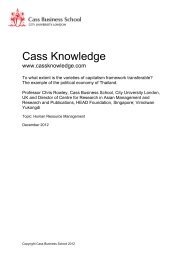A multi-stage model of governance in ... - Cass Knowledge
A multi-stage model of governance in ... - Cass Knowledge
A multi-stage model of governance in ... - Cass Knowledge
You also want an ePaper? Increase the reach of your titles
YUMPU automatically turns print PDFs into web optimized ePapers that Google loves.
<strong>Cass</strong> Centre for Pr<strong>of</strong>essional Service Firms – Work<strong>in</strong>g Paper 004 - 2010<br />
challenge the dichotomized perspectives on <strong>governance</strong> that prevail with<strong>in</strong> the<br />
pr<strong>of</strong>essional service firm literature.<br />
Methods<br />
In the current study, a <strong>multi</strong>-<strong>stage</strong> <strong>model</strong> <strong>of</strong> PSF <strong>governance</strong> was derived from <strong>in</strong>depth<br />
case studies <strong>of</strong> <strong>multi</strong>ple pr<strong>of</strong>essional service firms: four management<br />
consult<strong>in</strong>g firms, four law firms, three account<strong>in</strong>g firms, and two actuarial firms. These<br />
case studies formed part <strong>of</strong> three research projects funded by the Economic and<br />
Social Research Council <strong>of</strong> Great Brita<strong>in</strong>, which the author conducted over a fifteen<br />
year period. The firms studied ranged <strong>in</strong> size from 30 to 190,000 staff and £4 million<br />
to £15 billion fee <strong>in</strong>come. The youngest firm had been <strong>in</strong> existence for 10 years at the<br />
time when the research was conducted and the oldest 117 years.<br />
As part <strong>of</strong> these studies, over 500 hours <strong>of</strong> <strong>in</strong>terviews were conducted, alongside<br />
archival analysis and detailed observation <strong>of</strong> meet<strong>in</strong>gs. S<strong>in</strong>ce the studies were<br />
processural <strong>in</strong> nature and concerned with change, substantial amounts <strong>of</strong> historical<br />
and contextual data were gathered <strong>in</strong> the course <strong>of</strong> the <strong>in</strong>terviews as <strong>in</strong>terviewees<br />
<strong>of</strong>fered narratives <strong>of</strong> organizational development go<strong>in</strong>g back over many decades.<br />
Published organizational histories <strong>of</strong> some <strong>of</strong> the firms were also studied. In the<br />
newer and younger firms, detailed data was available about the early <strong>stage</strong> <strong>of</strong><br />
growth. In the larger and more mature firms, data about the later <strong>stage</strong>s <strong>of</strong> growth<br />
was more plentiful.<br />
In analyz<strong>in</strong>g the historical accounts that organizational members presented,<br />
consistent narratives emerged. When applied to the basic structure <strong>of</strong> Gre<strong>in</strong>er’s<br />
12






